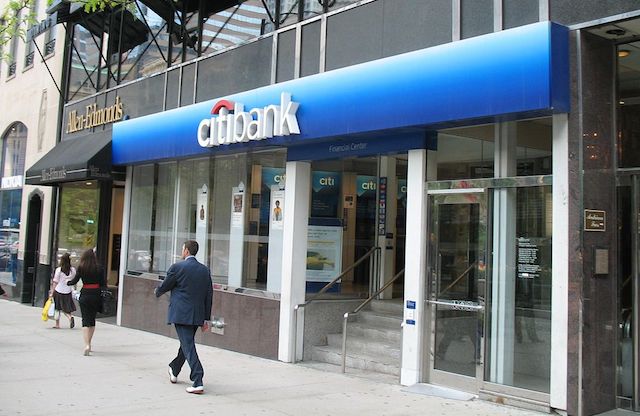Earlier this week, Citibank agreed to pay the largest federal civil penalty to date for their role in hawking dodgy subprime loans to consumers–disproportionately people of color–and then lying about their creditworthiness to potential investors. It is the latest sign that the collapse of the housing market six years ago continues to reverberate. Citibank’s admission of de facto fraud on Monday means that it will pay more than $7 billion to settle outstanding claims against its loan activities.
The announcement is bittersweet. It may in some small way go to help the nearly 4 million families at risk of losing their home right now. But the settlement comes too late for the nearly 13 million families, many black and brown, who’ve faced foreclosure since the crisis began. And despite the fact that Citibank will pay a historic cost for its wrongdoing, only a fraction of the total amount will go to help victims of the bank’s activities. Just $1 out of every $4 will go directly to help modify loans or help build new housing for affected communities. Most of the rest will go either to the U.S. Treasury and state coffers.
All of that said, Attorney General Eric Holder underscored the importance of the penalty by noting that, "Citi is not the first financial institution to be held accountable by this Justice Department, and it will certainly not be the last."
Given its history, the size of the punitive action against Citibank is of little surprise. The bank was one of the most active retailers of subprime mortgages on Wall Street. Next to Bank of America, another subprime mortgage printing press, Citibank received the largest share of TARP bailout funds–$45 billion of taxpayer money–to help it stabilize after the meltdown. The bank’s books were so full of the unfair, high-interest mortgages that two years after the height of the crisis The Wall Street Journal openly speculated about whether the federal government would let the financial behemoth fail.
It did not.
Even though the scale of what Citibank did is of little shock, the details of how they did it are enraging. In order to get to the heart of the wrongdoing here we have to go back to the scene of the crime: subprime mortgages.
As you probably remember, subprime mortgage loans were high-interest loans which had an initial, deceptively low interest rate. People of color who were qualified for traditional, steady-rate mortgages were nonetheless 70 percent more likely to be steered into these subprime loans. Subprime loans were so identified with people of color that brokers at Wells Fargo referred to them pejoratively as "mud people" loans.
But where the real money lay for banks was not necessarily in making these loans to homebuyers. Rather it was in repackaging and selling them in billion-dollar chunks to large institutional investors like pension funds and universities as "safe investments." Citibank excelled by dressing up and turning subprime loans into giant "mortgage backed securities."
Citibank knowningly mispresented subprime loans as safe investment vehicles. Internal e-mails released as part of the settlement show that "Citigroup employees learned that significant percentages of loans reviewed in due diligence had material defects." One person at Citibank responsible for selling the loan products said that buyers should "start praying" because he "would not be surprised if half of these loans went down."
Not only did Citibank push these busted loans on vulnerable communities and misleadingly re-sell them as high-quality investments, Citibank also corrupted the objective process that’s supposed to prevent these illicit practices.
As The Wall Street Journal lays out, before loans are sold to investors they are reviewed by an outside evaluator who essentially assigns them a grade to rate their investment caliber. This allows investors to know whether their products are quality or not. However, if Citibank didn’t like the results of a particular evaluation, it would practically erase the unbiased grade and assign a new one. Citibank would then turn around and sell the product with its bogus higher rating to unsuspecting buyers.
Of course, as the attorney general indicated, Citibank is not the only bank to engage in these activities. What continues to be astounding is just how consistent the sentiments and practices were across Wall Street firms. Echoing the "we’re selling to fools" sentiment of Citibank, former Goldman Sachs Vice President Fabrice Tourre told his girlfriend in an e-mail on the eve of the crisis, "the whole building is about to collapse now." Referring to himself in the third person, Tourre swaggered that the "only potential survivor" would be "the fabulous Fab … standing in the middle of all these complex, highly leveraged, exotic trades he created without necessarily understanding all of the implications of those monstruosities [sic]!!!" He was convicted last year of mortgage fraud.
Given the fact Citibank will be able to write off much of the penalty as a business loss means that the impact of Monday’s decision on Citibank’s bottom line is small. In fact on the same day of the settlement Citibank reported profits that beat analysts’ expectations. Even with the penalty, the company’s stock went higher on the profit news.
While it’s true that no one responsible for the mortgage mess has gone to jail, the positive element here is that however haltingly, the banks are being held to some account. This may be of little consolation to the tens of millions of individuals effected by their activities. But given that the financial sector continues to have some of the strongest cards in our winner-take-all economic system, there is some consolation that there was any justice rendered at all.
